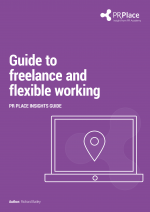PR Place guide to freelance and flexible working
Independent practitioner, consultant, contractor, freelance. But what’s the favoured term? The consensus from a PRCA Business of PR Freelancing conference this year was to stick to the word ‘consultant.’ Freelance is more suggestive of an unsalaried journalist.
Download: Guide to Freelancing and Flexible Working
The guide will help you to:
- Decide if freelance life is for you.
- Learn from others who have made the leap.
- Charge what you’re worth and get paid.

We respect your privacy and handle your data with care. Please see our privacy policy.
Thank you for downloading your free guide. Your download should start immediately. We are adding new guides all the time, so check back regularly.
If you asked us to keep you up to date with new guides and the latest industry insights, you will receive an email shortly asking you to verify the address we need to send them to.

